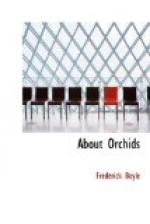“An orchid farm” is no extravagant description of the establishment at St. Albans. There alone in Europe, so far as I know, three acres of ground are occupied by orchids exclusively. It is possible that larger houses might be found—everything is possible; but such are devoted more or less to a variety of plants, and the departments are not all gathered beneath one roof. I confess, for my own part, a hatred of references. They interrupt the writer, and they distract the reader. At the place I have chosen to illustrate our theme, one has but to cross a corridor from any of the working quarters to reach the showroom. We may start upon our critical survey from the very dwelling-house. Pundits of agricultural science explore the sheds, I believe, the barns, stables, machine-rooms, and so forth, before inspecting the crops. We may follow the same course, but our road offers an unusual distraction.
It passes from the farmer’s hall beneath a high glazed arch. Some thirty feet beyond, the path is stopped by a wall of tufa and stalactite which rises to the lofty roof, and compels the traveller to turn right or left. Water pours down it and falls trickling into a narrow pool beneath. Its rough front is studded with orchids from crest to base. Coelogenes have lost those pendant wreaths of bloom which lately tipped the rock as with snow. But there are Cymbidiums arching long sprays of green and chocolate; thickets of Dendrobe set with flowers beyond counting—ivory and rose and purple and orange; scarlet Anthuriums: huge clumps of Phajus and evergreen Calanthe, with a score of spikes rising from their broad leaves; Cypripediums of quaint form and striking half-tones of colour; Oncidiums which droop their slender garlands a yard long, golden yellow and spotted, purple and white—a hundred tints. The crown of the rock bristles all along with Cattleyas, a dark-green glossy little wood against the sky. The Trianaes are almost over, but here and there a belated beauty pushes through, white or rosy, with a lip of crimson velvet. Mossiaes have replaced them generally, and from beds three feet in diameter their great blooms start by the score, in every shade of pink and crimson and rosy purple. There is Loelia elegans, exterminated in its native home, of such bulk and such luxuriance of growth that the islanders left forlorn might almost find consolation in regarding it here. Over all, climbing up the spandrils of the roof in full blaze of sunshine, is Vanda teres, round as a pencil both leaves and stalk, which will drape those bare iron rods presently with crimson and pink and gold.[8] The way to our farmyard is not like others. It traverses a corner of fairyland.




